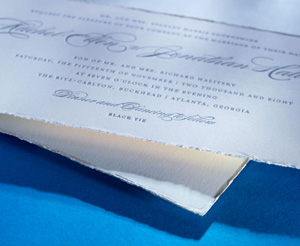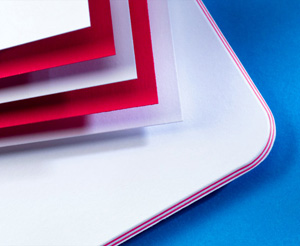A Laymanís Primer on Printing: Part 2
Printing, typography, and finishing-technique terminology
Our lines of funny greeting cards run the gamut from heartwarming to gut-busting. No matter your personality, politics or philosophy, you'll find the perfect card on our shelves. We use a variety of printing techniques that help us create beautiful custom-printed cards affordably and quickly—we were printing Trump "bigly birthday" cards faster than Russians could hack our computers.
Having a certain familiarity with commonly used terms is helpful when you need to order custom-printed materials, especially pieces as important as invitations and personalized stationery. From general terms to typography and finishing processes, here are some terms and techniques that are helpful to understand what they mean.
GENERAL TERMS
Camera-Ready: the stage at which material is ready to be photographed and made into printing plates.Copy: the text or material that you wish to print.
Die: a sharp metal form or block to cut or produce an image on the paper during the finishing process.
Four-Color Process: printing that produces a full range of color reproduction, especially photographs, using only four ink colors: cyan, magenta, yellow and black (CMYK). These are also known as "process colors."
Make-Ready: the process of getting the press set up and ready to print a job.
PMS Color: PMS stands for Pantone Matching System and refers to a standard for mixing inks to match a specific color or colors.
Stock: the type of paper you wish to use for your printed materials. Paper choices come in a range of colors, weights and finishes.
Turnaround Time: the amount of time required to produce a completed job from start to finish.
TYPOGRAPHY TERMS
Baseline: an invisible or imaginary line on which the type characters sit.Font: another term for the typeface, or specific design of the letters, being used for printed copy.
Leading: the space between lines of type. Originally, in hand-set type, thin slices of metal were placed between rows of type to create space between the lines.
Point Size: refers to the size of the characters in a type font. It is a measurement from the top of tallest character (i.e. an h) to the bottom of lowest character (i.e. y) plus a little extra lead for space and readability. A "point" is equal to approximately 1/72 of an inch.
Reverse Type: white type that prints on black, or a light color on a dark background or color.
Script: a typeface designed to look more like cursive handwriting.
Serif: refers to a short line embellishing the top and bottom ends of each stroke of a letter. Check out Times New Roman or Cambria on your computer as an example.
Sans Serif: a simple letter or character without any embellishment. Check out Arial or Impact on your computer as an example.
Swash: an extension or embellishment on the end of a letter or underneath a word for decorative effect.
FINISHING TECHNIQUES
Beveling or Beveled Edge: the process by which the edge of a heavy stock paper is cut at a 45-degree angle.Bordering: a process usually done by hand that puts a colored or foil border around the outside edge of the paper.
Debossing: a process that produces a recessed or depressed image or design into the paper, usually through the use of a die.
Deckling or Deckled Edge: a process that creates a ragged or torn-look edge to the paper that mimics the look of handmade paper.
Diecut: a process by which a shape or design is cut—or "punched out"—of the paper using a special sharp metal die or metal cutter. It can be likened to a process similar to a paper punch.
Embossing: a process that produces a raised design by pressing the paper into a die or engraving plate. Blind embossing is when no ink or foil is used in the embossing process—only the plain raised paper creates the image. Foil embossing is when a foil material is transferred to the design on the paper during the embossing process.
Foil Stamping: a process in letterpress that uses foil and dies to transfer foil for the design onto the paper. Hot stamping uses a heated die and pressure to transfer and adhere the foil to the paper.
Imprinting: a process by which additional material, such as a personalized greeting, is printed onto a piece after it has been printed.
Laminating or Layering: a process of bonding or "pasting" multiple layers of paper or card stock together—especially of different colors—for a special effect that is most commonly used for invitations.
Thermography: a process that raises the ink after printing to give the look of an engraved printed piece. A resinous powder added to the printing ink is heated and dried to imitate the raised look of engraved printing.
The above list represents a small portion of terms used in printing, but probably are the most commonly needed ones for the average person to know. When dealing with a printer, always ask them to explain exactly what they mean should they use an unfamiliar term while discussing your job to avoid any misunderstandings and ensure that your job is done to your expectations.







